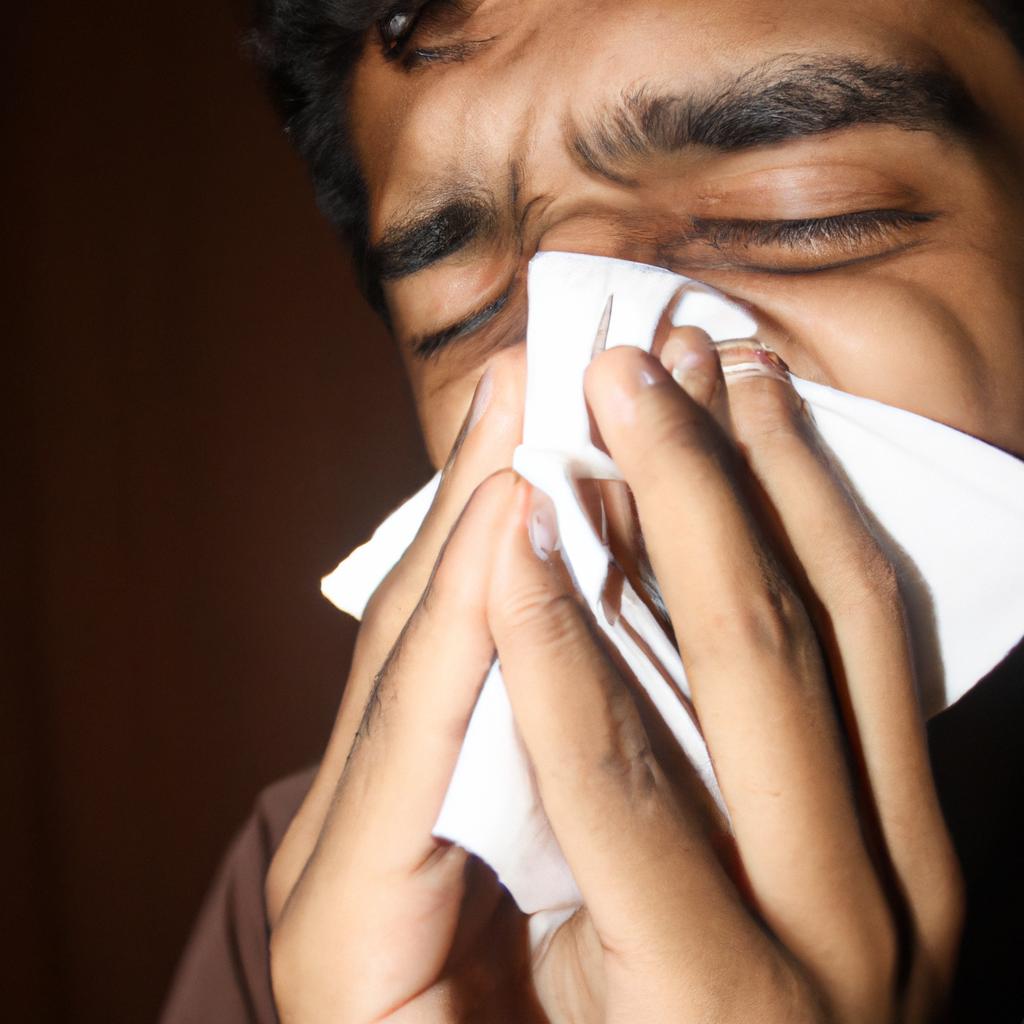Allergies, a common health condition affecting millions of individuals worldwide, can manifest in various forms and intensities. From mild symptoms such as sneezing and skin rashes to severe reactions like anaphylaxis, allergies can significantly impact one’s quality of life. Accurate diagnosis is crucial for effective management and treatment of allergies, yet it remains a complex task due to the diverse range of allergens and individual responses they elicit. To illustrate this complexity, consider the case study of Sarah, a 35-year-old woman who has been experiencing recurrent episodes of wheezing and shortness of breath whenever she is around cats.
Sarah’s troublesome symptoms suggest the possibility of her being allergic to cats; however, a definitive diagnosis cannot be made solely based on these observations. Diagnosing allergies involves comprehensive evaluation techniques that go beyond mere symptom recognition. This article aims to provide a guide on diagnosing allergies by exploring the different methods employed in clinical practice. By understanding the intricacies involved in allergy diagnosis, healthcare professionals will be equipped with essential knowledge to accurately identify allergens responsible for patients’ symptoms and develop appropriate management plans tailored to their specific needs. Additionally, individuals suffering from potential allergies can gain insights into the diagnostic process, enabling them to actively participate in their own healthcare journey and advocate for their needs.
The diagnostic process for allergies typically begins with a thorough medical history evaluation. This involves gathering information about the patient’s symptoms, their frequency and duration, as well as any potential triggers or exposures that may be associated with the symptoms. In Sarah’s case, her recurrent wheezing and shortness of breath around cats would be noted during this stage.
Following the medical history assessment, a physical examination is conducted to identify any visible signs or indicators of allergic reactions. In Sarah’s case, the presence of skin rashes or hives after contact with cats could be observed during this examination.
To further confirm or rule out specific allergens, allergy testing may be performed. There are two main types of allergy tests: skin tests and blood tests. Skin tests involve exposing the patient’s skin to small amounts of suspected allergens and monitoring for an allergic reaction. This can be done through prick tests, where a tiny amount of allergen is pricked onto the skin surface, or intradermal tests, where a small amount of allergen is injected under the skin.
In Sarah’s situation, a cat-specific allergen extract would likely be used in these tests to determine if she has sensitization to cat dander. If positive results are obtained from either type of skin test, it suggests that Sarah has an allergic response to cats.
Blood tests can also be utilized to diagnose allergies by measuring specific antibodies called immunoglobulin E (IgE) in the blood. These antibodies are produced by the immune system in response to allergen exposure. A high level of IgE antibodies against cat dander would support Sarah’s diagnosis of a cat allergy.
In some cases, additional diagnostic tools such as challenge tests may be necessary. Challenge tests involve controlled exposure to suspected allergens under medical supervision to observe any allergic reactions. However, these tests are typically reserved for more complex cases or when other diagnostic methods are inconclusive.
Once a diagnosis is confirmed, the next step involves developing an appropriate management plan. This may include allergen avoidance strategies, medication options such as antihistamines or corticosteroids to alleviate symptoms, and in severe cases, immunotherapy (allergy shots) to desensitize the immune system over time.
In conclusion, diagnosing allergies requires a comprehensive approach that combines medical history evaluation, physical examination, and allergy testing. By understanding the intricacies of this process, healthcare professionals can accurately identify allergens responsible for patients’ symptoms and develop tailored management plans. Likewise, individuals who suspect they may have allergies can actively participate in their own healthcare by seeking proper diagnosis and advocating for their needs.
Understanding the immune system
To comprehend how allergies develop and manifest in individuals, it is crucial to have a solid understanding of the immune system. The immune system is an intricate network of cells, tissues, and organs that work together to defend the body against harmful pathogens such as bacteria, viruses, and parasites. One example that highlights the role of the immune system in allergy development is Sarah’s case study.
Sarah, a 32-year-old woman with no prior history of allergies, suddenly experienced symptoms such as sneezing, itching eyes, and nasal congestion every time she was exposed to her neighbor’s cat. This allergic reaction puzzled her since she had always been around cats without any issues before. Understanding Sarah’s situation requires delving into the mechanisms underlying allergic reactions.
Allergies occur when the immune system reacts abnormally to harmless substances called allergens. When exposed to an allergen like cat dander or pollen, certain cells in the immune system release chemicals known as histamines. Histamines trigger a cascade of inflammatory responses throughout the body resulting in various symptoms associated with allergies. To provide clarity on this subject matter, here are some key points about allergies:
- Allergic reactions can range from mild discomfort to severe life-threatening conditions.
- Common allergens include pollen, dust mites, pet dander, certain foods (e.g., peanuts), insect venom (e.g., bee stings), and medications.
- Symptoms may affect different parts of the body, including respiratory tract (sneezing, coughing), skin (rash, hives), gastrointestinal tract (nausea, vomiting), or cardiovascular system (low blood pressure).
- Allergies can develop at any age; while some people outgrow their allergies over time, others may experience new sensitivities later in life.
This table illustrates common symptoms associated with allergic reactions:
| Symptom | Description |
|---|---|
| Sneezing | Rapid expulsion of air through the nose |
| Itching eyes | Intense irritation or discomfort in the eyes |
| Nasal congestion | Blockage or stuffiness in the nasal passages |
| Skin rash | Redness, swelling, and itching on the skin |
Understanding how allergies occur is essential for accurate diagnosis and effective management. In the subsequent section, we will explore common symptoms of allergic reactions to assist individuals in identifying and addressing potential allergens. By doing so, individuals can take proactive measures to minimize their exposure and alleviate allergy-related discomfort.
Common symptoms of allergic reactions
Understanding the immune system is crucial in diagnosing allergies. By comprehending how the body’s defense mechanisms function, healthcare professionals can identify potential triggers and develop effective treatment plans for patients experiencing allergic reactions.
Consider the case of Sarah, a 35-year-old woman who recently started experiencing symptoms such as sneezing, itchy eyes, and a runny nose whenever she encountered cats. These symptoms would persist for several hours after exposure to felines. Understanding her immune system’s response to cat allergens will help us explore common symptoms of allergic reactions further.
Allergic reactions occur when the immune system overreacts to harmless substances known as allergens. In Sarah’s case, her immune system mistakenly identifies proteins found in cat dander as harmful invaders. This triggers an immediate hypersensitivity reaction within her body. The following factors contribute to the development of an allergic reaction:
- Genetic predisposition: Certain individuals are more prone to developing allergies due to inherited genes.
- Environmental factors: Exposure to certain allergens over time can increase the likelihood of developing allergies.
- Immune system dysfunction: An imbalanced or dysregulated immune response may lead to heightened sensitivity towards allergens.
- Previous sensitization: Initial exposure to an allergen primes the immune system, resulting in future exaggerated responses upon subsequent exposures.
To better understand these factors, let’s consider a table that summarizes them:
| Factors | Description |
|---|---|
| Genetic predisposition | Some individuals have a higher chance of developing allergies due to their genetics. |
| Environmental factors | Exposure to specific allergens can increase the risk of allergy development. |
| Immune system dysfunction | Imbalances or dysregulation within the immune system may contribute to allergies. |
| Previous sensitization | Initial exposure primes the immune system for stronger reactions in subsequent encounters with allergens. |
In conclusion, understanding how our bodies react to different substances is vital in diagnosing allergies. By recognizing the immune system’s response to allergens, healthcare professionals can accurately identify allergic reactions and provide appropriate treatment plans tailored to each patient’s needs. Next, we will explore the various types of allergy tests available.
Now let’s delve into the different types of allergy tests.
Types of allergy tests
Diagnosing Allergies: A Guide in Health Conditions and Diseases
Common symptoms of allergic reactions can vary widely depending on the individual and the specific allergen involved. However, there are several common signs that may indicate an allergic response. For instance, let’s consider a hypothetical case study involving Sarah, a 35-year-old woman with known allergies to peanuts. One day, after accidentally ingesting a small amount of peanut butter, she experienced immediate itching and swelling around her mouth, followed by difficulty breathing and hives all over her body.
When it comes to identifying potential allergies, healthcare professionals rely on various methods of testing. These tests aim to determine the specific allergen triggering an individual’s immune system response. There are four main types of allergy tests commonly used:
- Skin prick test: This involves placing a small amount of the suspected allergen on the skin and then pricking or scratching the area to allow exposure. If an individual is allergic to that substance, they will typically develop a localized reaction at the site within minutes.
- Blood test: Also known as RAST (radioallergosorbent test), this method measures the presence and levels of specific antibodies called immunoglobulin E (IgE) in the blood associated with particular allergens. It provides information about an individual’s sensitization level but does not necessarily confirm clinical allergy.
- Patch test: Primarily used for diagnosing contact dermatitis caused by substances like metals or chemicals, this test involves applying patches containing different allergens to the skin for 48 hours to evaluate delayed hypersensitivity reactions.
- Elimination diet: In cases where food allergies are suspected, individuals may be advised to follow an elimination diet under medical supervision. This involves removing potentially problematic foods from their diet one at a time while closely monitoring symptoms.
Understanding these different diagnostic approaches can help individuals navigate their journey towards identifying and managing their allergies effectively.
| Allergy Test | Purpose |
|---|---|
| Skin prick test | Determines immediate allergic reactions |
| Blood test (RAST) | Measures IgE antibodies associated with specific allergens |
| Patch test | Identifies delayed hypersensitivity reactions for contact dermatitis |
| Elimination diet | Helps identify food allergies through systematic elimination |
Moving forward, we will delve into the process of diagnosing food allergies and explore various techniques used to determine which foods may be triggering adverse immune responses. By understanding these diagnostic methods, individuals can gain insight into their own health conditions and take appropriate measures to ensure their well-being.
Diagnosing food allergies
In the previous section, we discussed various types of allergy tests that can help diagnose allergies. Now, let’s delve deeper into diagnosing food allergies, a specific type of allergic reaction that affects many individuals.
Imagine a scenario where Sarah, a 10-year-old girl, experiences recurrent episodes of hives and abdominal pain shortly after consuming certain foods. Her concerned parents decide to seek medical advice for an accurate diagnosis.
To determine if someone has a food allergy, healthcare professionals utilize several diagnostic methods:
- Skin prick test: In this test, small amounts of allergen extracts are placed on the skin surface using tiny needles or probes. The presence of an allergic response is indicated by the appearance of redness or swelling at the site within minutes.
- Blood tests: These include measuring specific immunoglobulin E (IgE) antibodies in the blood against suspected allergens. Elevated levels may suggest an immune system response to particular substances.
- Elimination diet: A carefully planned approach involves removing potential trigger foods from one’s diet and reintroducing them systematically while monitoring symptoms closely.
- Oral food challenge: This controlled procedure involves consuming increasing amounts of a suspected allergenic food under medical supervision to confirm or rule out an allergy.
Here is an emotional bullet point list highlighting the impact of undiagnosed food allergies:
- Anxiety and fear associated with unknown triggers
- Frequent discomfort and pain affecting daily life
- Social isolation due to dietary restrictions
- Potential long-term health consequences if left untreated
Now consider this table outlining common symptoms experienced during a food allergic reaction:
| Symptom | Description | Example |
|---|---|---|
| Hives | Raised itchy bumps on the skin | Sarah developed large hives after eating peanuts |
| Abdominal pain | Sharp cramps or discomfort in the stomach area | After consuming dairy, Sarah experienced sharp abdominal pain |
| Swelling | Increased size or puffiness in specific areas | Sarah’s lips swelled after eating shellfish |
| Difficulty breathing | Shortness of breath or wheezing | Following ingestion of tree nuts, Sarah had difficulty catching her breath |
As we can see from the example and emotional bullet points, diagnosing food allergies is crucial for individuals like Sarah to lead a healthy and fulfilling life.
“Moving on to diagnosing environmental allergies…”
Diagnosing environmental allergies
Diagnosing Environmental Allergies
Imagine a scenario where Sarah, a 35-year-old woman, experiences persistent sneezing, itchy eyes, and nasal congestion whenever she spends time outdoors. She suspects that her symptoms may be due to environmental allergies but wants to confirm the diagnosis. In this section, we will explore the process of diagnosing environmental allergies and how healthcare professionals go about identifying the specific triggers.
To diagnose environmental allergies accurately, healthcare professionals employ various methods and tools. These include:
-
Medical History: The first step in diagnosing environmental allergies is obtaining a detailed medical history from the patient. This involves questions about their symptoms, when they occur, and any potential triggers or exposure to allergens.
-
Physical Examination: A physical examination is then conducted by the healthcare professional to assess any visible signs of an allergic reaction such as redness or swelling of the skin, watery eyes, or nasal congestion.
-
Allergy Testing: Allergy testing plays a crucial role in pinpointing the specific environmental allergens responsible for triggering an individual’s symptoms. There are two primary types of allergy tests performed:
-
Skin Prick Test: During this test, small amounts of suspected allergens are applied to the skin through gentle pricks or scratches. If a person is allergic to one or more substances, an allergic reaction (redness or swelling) occurs at the site.
-
Blood Test: Another method used for allergy testing is measuring IgE antibodies in the blood sample taken from the patient. Elevated levels of these antibodies indicate sensitivity to particular allergens.
-
-
Elimination Diet: In some cases where food allergies might also contribute to environmental allergy symptoms, an elimination diet can help identify potential dietary triggers that worsen symptoms.
The table below summarizes common diagnostic methods used for determining environmental allergies:
| Diagnostic Method | Description |
|---|---|
| Medical History | Detailed questioning about symptoms and triggers |
| Physical Examination | Assessment of visible signs and symptoms |
| Skin Prick Test | Application of allergens to the skin to observe reactions |
| Blood Test | Measurement of IgE antibodies in blood samples |
| Elimination Diet | Identification of potential dietary triggers |
Understanding an individual’s specific environmental allergies is crucial for providing appropriate treatment and management strategies. By utilizing a combination of medical history, physical examination, allergy testing, and sometimes elimination diets, healthcare professionals can accurately diagnose environmental allergies.
Moving forward, let us explore when it becomes necessary for individuals experiencing allergy symptoms like Sarah’s to seek professional medical advice. This will ensure prompt diagnosis and appropriate interventions to alleviate discomfort caused by these allergic reactions.
When to see a healthcare professional
Diagnosing Allergies: A Guide in Health Conditions and Diseases
In the previous section, we discussed the process of diagnosing environmental allergies. Now, let’s explore when it is appropriate to seek professional healthcare advice for allergy-related concerns.
Imagine a scenario where Sarah, a 35-year-old woman, experiences persistent sneezing, watery eyes, and nasal congestion every time she steps outside her house. These symptoms have been affecting her daily life for several months now. Despite trying over-the-counter remedies and avoiding potential allergens, Sarah finds no relief. This case highlights the importance of knowing when to consult a healthcare professional for proper diagnosis and treatment.
Recognizing the need for medical guidance can save individuals from unnecessary suffering caused by undiagnosed or unmanaged allergies. Here are some key indicators that suggest seeking professional help:
- Symptoms persist despite home remedies or over-the-counter medications.
- Allergy-like symptoms interfere with daily activities or significantly impact quality of life.
- Difficulty identifying specific triggers or patterns related to allergic reactions.
- Suspected severe allergic reaction requiring immediate attention.
To emphasize the significance of consulting medical experts regarding allergies, consider the following table highlighting common misconceptions about self-diagnosis versus seeking professional evaluation:
| Myths About Self-Diagnosis | Facts About Professional Evaluation |
|---|---|
| Over-reliance on internet searches can lead to inaccurate information | Healthcare professionals possess specialized knowledge and resources for accurate diagnoses |
| Misinterpretation of symptoms may result in misdiagnosis | Professionals conduct comprehensive assessments using diagnostic tests and clinical expertise |
| Delayed treatment due to hesitation in seeking medical advice | Timely intervention helps prevent worsening symptoms and complications |
Acknowledging these myths empowers individuals to make informed decisions about their health while recognizing the value of expert opinion.
When considering whether to see a healthcare professional for allergy-related concerns, remember that early intervention promotes effective symptom management and improves overall well-being. By seeking professional evaluation, individuals can access appropriate treatments and develop personalized strategies to alleviate allergic reactions, leading to a better quality of life.
Now that we understand the importance of consulting healthcare professionals for allergy-related concerns, let’s explore various treatment options available in the next section.
 Web Firma
Web Firma



